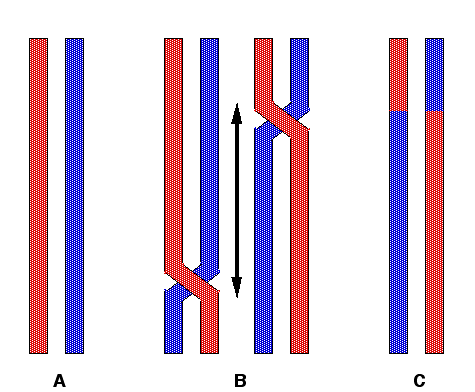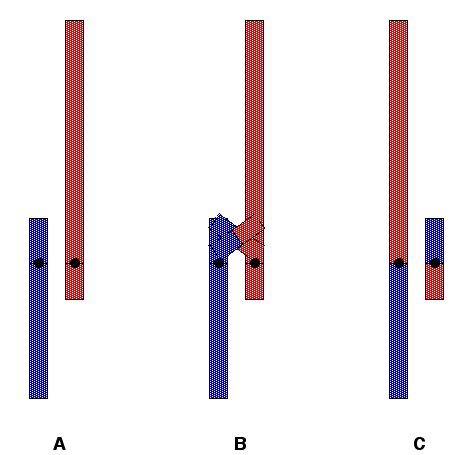
| MadSci Network: Evolution |
Hi Dan,
That’s a very astute question. Differences in chromosome number seem to be one form of barrier to inter-breeding between individuals of related species, but as I think you will see below, some differences in chromosome number might just be coincidental with some other species barrier.
First of all, what is a chromosome? A chromosome is a large structure composed of DNA, RNA and protein, which serves as the storage medium for some or all of an organisms genetic information (in the form of DNA). Even though there are RNA molecules and proteins associated with the protein, each chromosome is organized along a single very long DNA molecule. The number of chromosomes you have is called your "ploidy" number (n). So if you have two of every chromosome (in pairs for example), you are diploid (2n), because "di" means "two". If you have three, you are triplod (3n), and if you have four you are tetraploid (4n). If you only have half of each pair, you are haploid (n). The collection of all of your chromosomes is called the genome. Eukaryotes (plants, animals, and fungi) have two copies (called chromosome pairs) of each chromosome in their cells, and when these organisms reproduce, they line their paired copies up together and duplicate them, and the duplicates are separated from the originals.
Now, lets look at some of the mechanisms that can generate changes in chromosome number. First off, you have to remember that differences in chromosome numbers are largely relative. This is because we have to compare closely related species to recognize changes in chromosome numbers. If one species has 22 pairs of chromosomes and a second, closely related species has 23 pairs of chromosomes, it is difficult to say if the first species 'lost' a pair of chromosomes or if the second species 'gained' a pair. The only way to be sure what happened is to look at numerous species which we assume are all descended from a recent common ancestor, and then assume that the most common chromosome number was the same in the ancestral species, from which all the others are descended.
When chromsome pairs duplicate, they first line up along side one another and exchange parts in a process called, "cross-over". An cartoon model of this is shown below. In this figure, the red and blue boxes represent chromosomes in a pair (part A). The "cross-over" and the cross-over point can move up and down the length of the chromosome, as shown in B. If it does not go all the way to the end when the chromosomes are separated, then they will have exchanged some sections, as you can see in part C.

|
| Figure 1 : Cross-over |
Non-Disjunction
When complex eukaryotes like humans replicate, we create specialized cells ("gametes", known as sperm and ovae) that have half as many chromosomes as the rest of our cells. Instead of having a pair of each chromosome, these gametes only have one of each chromosome. Gametes form to fuse cells that have pairs of chromosomes, half of each pair comes from a sperm, and the other half from an ovum. When new chromosomes are being made, on very rare occasions, the new copies will fail to separate (or "disjoin") from the original copy. When this happens, one gamete will get an extra copy of the chromosome that failed to disjoin, and the other gamete will get no copy. This is called a non-disjunction. In this case, the sperm that got two copies will fuse with an ovum that had one copy, and the resulting cell would have three copies of that chromosome.
Usually, having an extra copy of a chromosome due to a non-disjunction is fatal, and the cell dies. In the three or so billion years that eukaryotes have been around, some organisms with non-disjunctions managed to survive by finding new uses for the genes on that extra chromosome. Of course, this begs the question of who you mate with when you have a different number of chromosomes, and I will get to that later.
Another way to increase your chromosome number is by duplicating all of your chromosomes, in a sort of whole genome non-disjunction resulting in polyploidy. This seems to work alright for plants, but for animals, this is very very rare, because of the way animals reproduce, as you pointed out above. However, there many examples of tetraploid (4n) and hexaploid (6n) insects, triploid and tetraploid fish (Catfish, Cyprinids and Carp), and even a hexaploid fish (a subspecies of the tetraploid Carp). There are also several tetraploid species of claw-toed frogs, and even a tetraploid rat (the red viscacha rat, or Tympanoctomys barrerae)! In the case of this rat species, the number of chromosomes (102) is much lower than you would expect by looking at closely related rat species. Based on these relatives, you would expect the tetraploid rat to have 112 chromosomes, which brings us to the next mechanism for changing chromosome numbers.
Translocation
Translocation is what happens when two chromosomes that are not part of a pair get stuck together as if they were a pair, and exchange segments. If the segments that get exchanged are large enough, you can have most of both chromosomes moved onto one single chromosome, as shown below. In this figure, the blue and red boxes are cartoons of two different chromosomes. The black dots in their centers represent the "centrosomes" where the cell attaches filaments that drag the chromosomes around. When these chromosomes cross-over, the result is two chromosomes are very different size. One larger chromosome, contains almost all of the genetic material of the two chromosomes, while the other smaller chromosome contains almost none. In this example, the material from one chromosome has been moved or "translocated" onto another chromosome. In dramatic cases like this one, the resulting tiny chromosome is usually lost, and the resulting chromosome count is reduced by one.

|
| Figure 2 : Translocation |
This is probably what happened during the evolution of the apes. All three species have very similar chromosomes, but humans have 23 pairs of chromosomes, while chimpanzees, gorillas, and orangutans have 24 pairs. Each end of human chromosome number 2 (the second largest human chromosome) looks very similar to the long end of a pair of gorilla or chimpanzee chromosomes, suggesting that the common ancestor of these three species had 24 chromosomes and that humans lost one chromosome due to translocation sometime in the six million years that have passed since that ancestral species lived.
Barriers To Interbreeding
Now differences in chromosome number do not serve as reproductive barriers between all species. For example, lets look at some of the equine species ( horses and donkeys). Domesticated horses have 32 pairs of chromosomes and Donkeys have 31. Yet, they can produce offspring, mules, which have 31.5 pairs of chromosomes. One of the horse chromosomes goes unpaired. Wild mountain zebras have 16 pairs of chromosomes, while the last species of wild horse (Przewalski's Horse) has 33 pairs. However, all of these equine species can produce hybrid offspring. In all of these crosses but one, the offspring are sterile. It has long been argued that this sterility is due to the difference in chromosome number, but hybrids of the wild (33 pairs) and domesticated horse (32 pairs) are fertile, and have 32.5 pairs of chromosomes. So clearly, something more than just differences in chromosome number is contributing to the species interbreeding barrier.
So, you've got a new chromosome…
Now Dan, you asked a very astute question, which was how individual organisms that have undergone non-disjunctions or translocations and survived manage to reproduce. Well, in some cases, as is likely with the equine species, the translocated segments of different chromosomes are still able to pair up and cross-over even though there might be more than two centromeres involved. An example of this is shown in the figure below, where the two upper chromosomes could have come from a wild horse with 33 pairs of chromosomes, while the bottom chromosome could have come from a domesticated horse with 32 pairs. If this were possible, a population of horses with 32, 32.5, and 33 pairs of chromosomes would develop, and the difference in chromosome number to might eventually come to reinforce behavioral, physical or biochemical differences (like the differences between horses and donkeys) between horse types, resulting in a barrier to interbreeding between species.

|
| Figure 3 : Pairing between translocated and non- translocated chromosomes |
However, not every pair of closely related species can interbreed as easily as the equines can. What happens when you have a translocated chromosome or an extra non-disjoined chromosome, and most of the hybrid offspring with your non-translocated relatives are sterile, or even completely inviable? In that case, the only candidates you have to mate with are your siblings and your own offspring, and your offspring with their siblings and their offspring. In this case, the only solution, the only way to successfully reproduce, is by inbreeding.
This is probably what happened early in the evolution of our own species. If you look at the estimates of genetic diversity for our own species and compare these values to our closest relatives, the gorillas and chimpanzees, you will see that the entire human population, all six billion of us, have about the same genetic diversity as a population of chimpanzees. Even though it might seem like we are all very different from one another, genetically, we are a very highly inbred species, probably in part because our most distant ancestors had no one to breed with but their close relatives.
Summary
So, to wrap up, changes in chromosome number are not really caused by mutations. Mutations are changes to the DNA sequence that occur during DNA replication and repair. Some people might argue that translocations result in large additions and deletions of DNA sequence, but that is not what people are generally referring to when they use the term mutations. Instead, changes to chromosome numbers are brought about when errors occur in the process of chromosome duplication (of which DNA replication is only a small part).
Finally, it seems like changes in chromosome number are not the ultimate barrier to species interbreeding. Some hybrids of species with different chromosome numbers are fertile, and chromosome pairing is still possible even when the number of chromosomes is different. It seems possible that in these cases, speciation occurs as the result of severe inbreeding, where close relatives share the new number of chromosomes, as well as a number of other minor differences which might accumulate and result in a set of behavioral, physical, or biochemical differences that serve to distinguish the two newly separate species. Of course, that is a topic for another Mad Scientist question.
I hope this answers some of your questions.
Try the links in the MadSci Library for more information on Evolution.